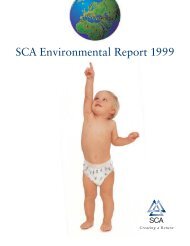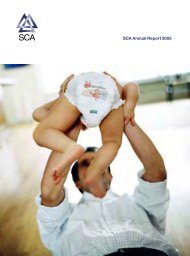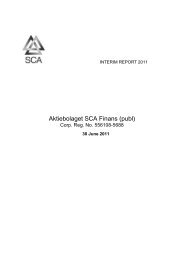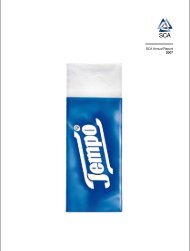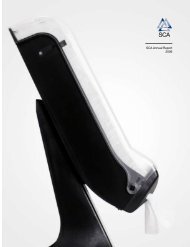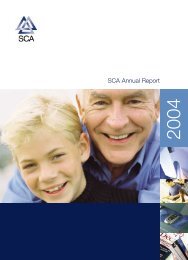Annual Report 1998
Annual Report 1998
Annual Report 1998
Create successful ePaper yourself
Turn your PDF publications into a flip-book with our unique Google optimized e-Paper software.
14<br />
annually. Among the fluff products, there is a strong 10%<br />
growth in incontinence products. Sales of baby diapers are<br />
rising sharply in Central and Eastern Europe, while demand is<br />
increasing only slightly in Western Europe. The same situation<br />
applies in the case of feminine hygiene products.<br />
Such American producers of hygiene products as Procter &<br />
Gamble and Kimberly-Clark market their products mainly under<br />
their own brands. Fort James, like SCA, sells its products<br />
under its own brands and under retailers’ private labels. (See<br />
diagram on page 17). New, higher-quality products are being<br />
introduced continuously and constitute an increasingly important<br />
competitive weapon.<br />
Up to now the financial uneasiness throughout the world<br />
has had a limited impact on sales of hygiene products. Demand<br />
in Russia has declined, however, while markets in Asia and<br />
South America are relatively unaffected. The growth in sales of<br />
hygiene products in these less developed markets is expected to<br />
be substantial in the future.<br />
Retail trade<br />
Sales to consumers in Europe of such hygiene products as tissue<br />
and feminine hygiene items, as well as baby diapers, are<br />
made to a large extent via retailers. Equal amounts of tissue<br />
products are sold under the manufacturers’ brands and the<br />
brands (private labels) of retailers. Private labels account for<br />
20% of the sales of baby diapers and feminine hygiene products.<br />
The total retail market is valued at SEK 90 billion.<br />
Growth is relatively slow, approximately 2% per year.<br />
A concentration and internationalization is taking place<br />
among the retail chains. The chains have a growing interest in<br />
selling high-quality hygiene products under private labels.<br />
The retail trade outside Europe and the United States is<br />
more fragmented. Brand name products are showing strong<br />
growth in these areas.<br />
Procter & Gamble<br />
Tissue and fluff products<br />
Competitors – Europe<br />
SCA<br />
Kimberly-Clark<br />
Fort James<br />
Johnson & Johnson<br />
0 5 10 15 20 25 30<br />
Sales, SEK bn<br />
Fluff Tissue<br />
There are a limited number of players in the European fluff and<br />
tissue industry.<br />
Tissue and fluff products<br />
SCA’s market shares – Europe<br />
%<br />
50<br />
40<br />
30<br />
20<br />
10<br />
0<br />
Tissue<br />
Baby diapers<br />
AFH market<br />
The principal items sold in the AFH market are tissue products<br />
used in industrial and commercial companies, hotels and<br />
restaurants, health-care institutions and other public establishments.<br />
These products are distributed via wholesalers and<br />
service companies or directly to individual customers. The<br />
market in Europe is valued at approximately SEK 25 billion.<br />
The growth amounts to approximately 3% per year.<br />
Hand wiping products, along with toilet paper, are the<br />
dominant products. The tissue products for hand wiping are<br />
taking market shares from other drying systems such as those<br />
employing hot air and textile hand towels.<br />
Important competitive advantages include offering customers<br />
a complete concept of installation-ready paper products<br />
(paper and holder, etc.) along with good service and rapid<br />
deliveries.<br />
Market for incontinence products<br />
Incontinence products used in health care and nursing facilities<br />
are distributed directly to hospitals and nursing homes, as well<br />
as via pharmacies or the retail trade, depending on the health<br />
insurance system in the individual country. The products provide<br />
protection for light and heavy incontinence.<br />
Sales in the markets in Western Europe and North America<br />
amount to approximately SEK 10 billion in each region. The<br />
growth, on average, amounts to between 8% and 10% per<br />
year. Growth in regions of Southeast Asia and South America<br />
is higher. In Western Europe, sales of products for light incontinence<br />
are being made through more and more channels<br />
and the annual growth amounts to 20%. The total potential<br />
throughout the world is substantial, since only 20% of all persons<br />
who need help are using, or have access to, incontinence<br />
products.<br />
Feminine hygiene products<br />
Incontinence products<br />
SCA strengthened its market position<br />
within several product areas in Europe.<br />
Incontinence products<br />
Market shares – the world<br />
Other SCA<br />
35%<br />
24%<br />
Hartmann<br />
6%<br />
Kendall<br />
11%<br />
SCA has strengthened its position as the<br />
world’s leading supplier of incontinence<br />
products.<br />
Procter &<br />
Gamble<br />
12%<br />
Kimberly-Clark<br />
12%




